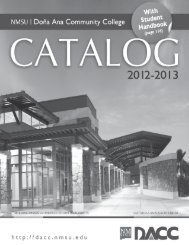online - Dona Ana Community College - New Mexico State University
online - Dona Ana Community College - New Mexico State University
online - Dona Ana Community College - New Mexico State University
Create successful ePaper yourself
Turn your PDF publications into a flip-book with our unique Google optimized e-Paper software.
OEHS 206 Travel and Tourism Operations (3)<br />
OEHS 216 Event, Conference, and Convention<br />
Operations (3)<br />
FOOD AND BEVERAGE/CULINARY ARTS EMPHASIS (15)<br />
OEHS 210 Banquet Operations (3)<br />
OEHS 211 Food Production Principles (3)<br />
OEHS 212 Advanced Food Preparation (3)<br />
OEHS 213 Professional Baking Operations (3)<br />
OEHS 214 Purchasing and Kitchen Mgt. (3)<br />
Law Enforcement<br />
Associate of Applied Science Degree<br />
• Corrections<br />
• Law Enforcement<br />
Associate of Criminal Justice<br />
527-7630<br />
The Law Enforcement program curriculum is designed to be completed<br />
within two years and provides classroom instruction leading<br />
to an associate degree in the fields of corrections or law enforcement.<br />
This program provides courses to prepare for entry-level careers<br />
in agencies at the local, state, and federal levels, as well as<br />
private agencies. Some of the career areas available to graduates are<br />
law enforcement, private security and related services, adult and<br />
juvenile corrections, probation and parole, law, and others.<br />
Those currently working as career officers in law enforcement can<br />
also benefit from the program, which can provide them with a better<br />
understanding of their roles in the criminal justice system while<br />
helping them prepare for higher level positions within their organizations.<br />
The Corrections Option<br />
The Corrections option emphasizes the correctional aspect of the<br />
criminal justice systems and offers a broad understanding of correctional<br />
institutions and alternatives. General studies are offered to<br />
students seeking employment in confinement facilities, institutional<br />
security, and other similar programs. The student also is prepared to<br />
work in adult and juvenile correctional agencies at the local, state,<br />
and federal levels.<br />
Workers in the corrections field are responsible for overseeing<br />
individuals who have been arrested and are awaiting trial or<br />
who have been convicted of a crime and sentenced to serve<br />
time in a jail, reformatory, or penitentiary. The majority of officers<br />
are employed by local, county, state, and federal institutions.<br />
The primary mission of corrections is protection of the public; however,<br />
many of the fields are involved with the treatment, education,<br />
and reintegration of offenders. These officers may find employment<br />
as wardens, jail administrators, program coordinators and counselors,<br />
public information officers, correctional trainers, case managers,<br />
probation/parole officers, corrections officers, detention officers<br />
or other related careers.<br />
The Law Enforcement Option<br />
The Law Enforcement option emphasizes the law enforcement aspect<br />
of the criminal justice system. This degree offers the law enforcement<br />
student a general understanding of the police officer’s<br />
multifaceted role in the United <strong>State</strong>s. It also prepares the student<br />
with the basic foundations of police work for possible employment<br />
opportunities with local, state and federal governments, and private<br />
industry.<br />
Most law enforcement officers are employed by the security industry<br />
and local, county, and state governments. They have duties that<br />
range from providing security to controlling traffic to preventing and<br />
investigating crimes. They maintain order, enforce laws and ordinances,<br />
issue traffic summonses, investigate accidents, present evidence<br />
in court, serve legal documents for the court system, and apprehend,<br />
arrest and process prisoners. Career opportunities include<br />
positions as private investigators, security officers, loss-prevention<br />
officers, police officers, sheriff and deputy officers, criminal investigators,<br />
game wardens, private detectives, and bailiffs.<br />
Many law enforcement agencies encourage the applicants to take<br />
postsecondary school training in law enforcement-related subjects.<br />
Many entry-level applicants for police jobs have completed some<br />
formal postsecondary education and a significant number are college<br />
graduates. Knowledge of a foreign language is an asset in many<br />
federal agencies and urban departments.<br />
Additional information on professional requirements and qualifications<br />
may be obtained from the U.S. Department of Labor, Bureau<br />
of Labor Statistics, at www.bls.gov.<br />
It is important to note that an articulation agreement exists with the<br />
Department of Public Safety of <strong>New</strong> <strong>Mexico</strong>.<br />
Associate Degree in Criminal Justice<br />
The associate of criminal justice introduces students to three facets<br />
of the criminal justice system: police, courts, and corrections.<br />
Broadly interdisciplinary—embracing the study of law, the humanities,<br />
and the natural, behavioral, and social sciences—the curriculum<br />
prepares students to transfer into the NMSU bachelor’s degree<br />
program in criminal justice, or the bachelor of applied studies, at the<br />
junior level. (Grade-point requirements apply.)<br />
Unless a student is on a SOCAD agreement, the last 15 credits must<br />
be completed at DACC or another campus of NMSU offering the<br />
program.<br />
In order to receive credit toward either the associate degree or the<br />
bachelor’s degree, a student must receive a C or better in all courses.<br />
Associate Degree:<br />
Corrections/Law Enforcement (66 credits)<br />
NOTE: Courses appearing in italics may be applied toward a bachelor’s<br />
degree at NMSU.<br />
OR<br />
OR<br />
OR<br />
Core Requirements<br />
25 – 26 credits<br />
COMM 253G Public Speaking 3<br />
COMM 265G Principles of Human Communication<br />
C S 110G Computer Literacy 3<br />
OECS 105 Intro. to Microcomputer Technical<br />
ENGL 111G Rhetoric and Composition 4<br />
ENGL 218G Technical & Scientific Communication 3<br />
BOT 209 Business & Professional Communication<br />
GOVT 100G American National Government 3<br />
PSY 201G Introduction to Psychology 3<br />
2 0 0 7 - 2 0 0 8 C A TA L O G<br />
53

















